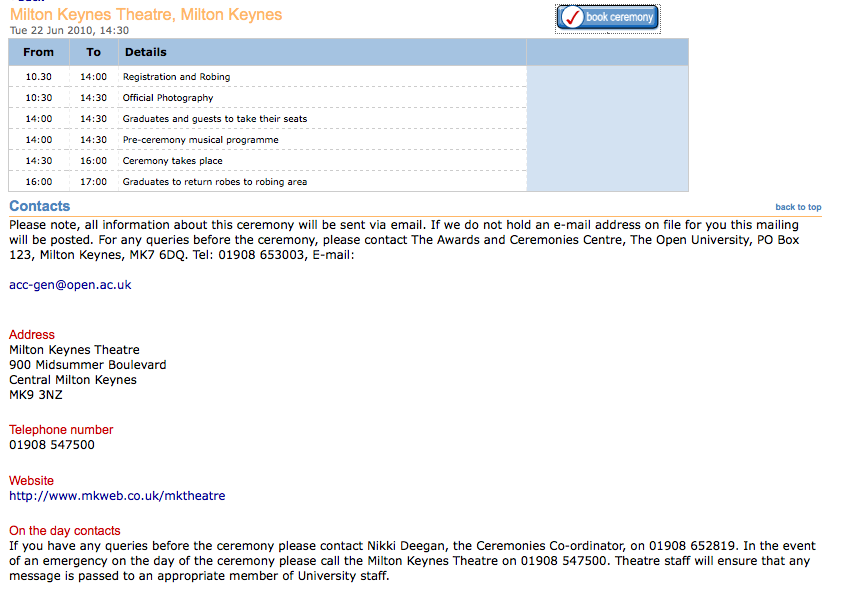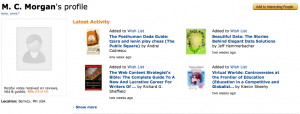
Communication and collaboration
(Notes from the Technology Enhanced Learning event at The Open University on 9 Feb)
Sharon Monie – LTS
Further examples of communication and collaboration
| Blog | L140 (personal reflection)
B201 (group comment and responses to reflective questions) |
| Database | D872 (graphically calculates and displays collated results) |
| Elluminate | Library (live bookable information literacy session)
L203 (student-only sessions in ALE (alternative learning experience). Speaking assessments) |
| Forums | H810 (topic specific group forums) B777 (intense use in activity groups) K311 (separate tutor group forums for online tutorials. |
| Glossary | L130 (student glossary of new and interesting vocabulary
AA100. Tutorial idea resource banks |
| Wiki | M883 Students adopt defined characters within a given scenario
T215 Group contributions and comments form part of one TMA SDK125 Group research and data within a set wiki template |
| Other | U1010 OpenDesign Studio. Image-based social web environment. Design Thinking needs the work and opinions of all its students to be a success. |
Technology Enhanced Learning: DSE232
(Notes from the Technology Enhanced Learning event at The Open University on 9 Feb)
Volker Patent DSE232
http://www3.open.ac.uk/study/undergraduate/course/dse232.htm
Applying Psychology – provides an example of a second-level course where the team spent some time considering how to use learning systems to help students communicate with one another online and use their online experiences to inform their assessment. The team will describe how the size, shape and scope of their asynchronous forums changes during the course, as students become more confident in working online.
- 15-point course. Recruits around 500 students each presentation. Just finished fourth presentation.
- Uses a range of VLE tools, including quizzes, wikis, fora and polls.
- Clear about learning outcomes: knowledge, comprehension, application, analysis, synthesis, evaluation
- Forum structure is provided and referred to as a meeting place, rather than created by tutors and students. Threads are under student and tutor control.
- Different design options. Single, course-wide forum. Used as a pre-course forum and one to support tutors. Multiple, parallel forums, which run for a few weeks. Single grouped forum for multiple groups. Each week’s forum becomes its own archive.
- Default in Moodle is to have a tutor group as equal to a forum group, but this does not afford team teaching. Team teaching needs to be built in from the start of the design.
- Use the polling tool to work out which subjects students are interested in, and to divide them into groups.
applying technology to help students communicate and collaborate
Andy Northedge: K101
(Notes from the Technology Enhanced Learning event at The Open University on 9 Feb)
http://www3.open.ac.uk/study/undergraduate/course/k101.htm
K101 An Introduction to Health and Social Care – a course in its second presentation that walks new students through different learning systems, encouraging students to communicate with one another before a major collaborative activity half way through the course. The course team will share with you why they took the approach to communications and collaboration that they did; how successful it has been and what their aspirations are for the future.
- Trying to replicate the dynamics of summer-school group work.
- Has been presented seven times
- Around 800 teams have started the project.
- Small teams work intensively without tutor intervention
- Less than 1% have not completed their project and produced a report.
- Quality of reports is impressive
- Students tend to be enthusiastic.
- Two weeks of highly coordinated teamwork halfway through course
- Agree a subject, review websites, submit reviews of two websites – team members review each others website, there is structured discussion
- 10% for team-forming tasks. No marks for team project report. 50% for individual essay, 30% for project-related skills and 10% for library skills
- Website provides narrative of activities, work of each member is displayed to entire team, each team has its own forum and sub-forums, collaborative activities are highly structured, time targets re closely managed and very visible. Students cannot complete tasks for other team members (as can happen at residential school). Teachers can track progress,
- Can compare website reviews.
- Discuss quality, breadth, access, trust, power and effects of websites – each of these in different forums.
- End up with a collectively written report. Can only alter their own section of the report – so if they want to change other areas, they need to discuss changes with that section’s author.
- Develop skills in independent inquiry, team working and information literacy.
Learnabout Fair
Advantages of a blogged research journal
Hyperlinks Link your research blogs to useful information sources
Personalisation Use emoticons and images to personalise entries
Categories and Search Find your notes quickly and efficiently
Blogroll, RSS feeds, trackbacks and permalinks Link to other researchers.
Ideas for a blogged research journal
Community Posts Collaborate and link with other academics.
Reflective Posts Discuss ideas, progress, methods, theory and academic writing.
Environmental Posts Share experience of the research environment.
Memos Things to do and remember; links and references.
Emotive Posts share how you feel about your research.
Blogging-related Posts Discuss blogging…
Wishing for our book
Someone is wishing for our book. Makes it seem sort of magical…

PhD student qualification rates
Information from a recent course on being a PhD supervisor, run by John Wakeford.
Of the 1996-7 cohort of full-time PhD students (excluding those not upgraded from MPhil and those not continuing into the second year):
- 30-36% had a doctorate after four years
- 50-70% had a doctorate after five years
- 72% had a doctorate after seven years
So about one in four of the students who initially register has a doctorate within one year of their funding running out.
These figures vary dramatically by university. The latest figures are that in 2007, seven years after starting their doctoral studies,
- 92% of those at Kings College, London, who had been upgraded had a doctorate
- 62% of those at The Open University who had been upgraded had a doctorate
- 26% at John Moore University, Liverpool, who had been upgraded had a doctorate
Success rates also depend on other factors: the best success rates are amongst international students, research council funded, over 30 at registration, with a first-class degree from other university, studying medicine or veterinary science. The worst success rates are amongst those who are UK industry sponsored, under 25 at registration, with a 2nd class degree from same institution, studying computing, architecture or languages.
How does one teach creativity?
Notes on a seminar given by Keith Sawyer.
Relevant literature includes:
Paul Torrance 1960s-80s – concerned with both teaching and assessing creativity. Torrance Test of Creative Thinking (TTCT) is still widely used in the US – primarily for admission into gifted and talented programmes.
Howard Gardner 1970s – brought cognitive psychology to bear on creativity (he also worked on multiple intelligences).
Woods and Jeffrey 1996 – creative teaching
Craft, 1997 – distinguished between creative teaching versus teaching for creativity
Carl Bereiter, 2002 – knowledge age
Sawyer, 2004 – disciplined improvisation
Schools have traditionally offered an industrial-age model of teaching and learning. Instructionism (term coined by Seymour Papert): implicit understanding of what schools should look like. Assumes that knowledge is a set of static facts and procedures. Goal of schooling is to get these facts and procedures into students’ heads. Teachers know these facts and procedures and their job is to transmit them.
|
Creative |
Instructionism |
|
| Knowledge | Deeper conceptual knowledge | Set of static facts and procedures |
| Goal of school | Prepare students to build new knowledge | Get facts and procedures into students’ heads |
| Role of teacher | Scaffold and facilitate collaborative knowledge building | Transmit facts and procedures |
| Curriculum | Integrated and contextualized knowledge (within authentic practice) | Simple ideas and procedures should be learned first |
| Assessment | Formative and authentic | Assess how many of these facts and procedures have been acquired |
Emergence: higher-level properties and structures emerge from systems of lower level components in interaction. Features of emergence include unpredictability, irreducibility and novelty. Classic example is birds flocking in a V shape.
Creativity is emergent, in that it is a constant combination of many small ideas. Each idea builds incrementally on a chain of prior ideas. Creativity is accelerated in collaborative teams.
Collaborative emergence is a way of talking about how creativity emerges in small groups. It has some additional properties: moment-to-moment contingency, retrospective interpretation, and it is more likely to happen if you have equal participation.
Learning as emergent. Instructionist learning is not emergent. Creative learning requires unpredictability, irreducibility and novelty – and is more likely to happen where there is moment-to-moment contingency, retrospective interpretation and equal participation.
Case Study: The Exploratorium
Four weeks on site and carried out 47 one-hour interviews. Attended many internal meetings and studied internal documents and memos. They engage in three model practices:
- Fostering creative learning
- Designing creative learning environments
- Educating creative teachers.
Fostering creative learning
There is an emphasis on compelling phenomena that draw the attention. This must allow hands-on interactivity. You are provoked to inquire about it and you end up with learning that is directed by the learner.
Designing creative learning environments
- They have an organic culture with low boundaries, flat organization and weak formal authority.
- Rapid prototyping
- There is an external focus – for example, on scientists, artists and innovative companies.
Educating creative teachers
Have a deep commitment to inquiry – with a formal mission to change how the world learns.
Challenges encountered
There are many pressures for such science centres to become more like school. How do you reconcile free-choice learning with standards? How do we guide bottom-up innovation and top-down guidance? How do we ensure that distinct innovations connect to build coherent integrated learning? How to foster emergent learning that is guided by curricular structures and intended learning outcomes?
Why reviewers/editors reject articles
Notes from a workshop on ‘Writing for peer-reviewed journals’ run by Pat Thomson.
Reasons why reviewers and editors say they reject articles:
- Lack of focus – saying everything, focusing on nothing, cramming too much in one article
- Not locating the contribution and the position – for a particular audience, in relation to wider debates. the specific conversation int his journal
- Poor organisation – not guiding the reader, poor headings, not enough signposts, too many signposts
- Failing to convince the reader – does not adequately deal with the methodology
- Not significant – too local, done a lot, doesn’t add anything
- Sounding like a n00b rather than an equal – assumes significance, sounds tentative, overclaims
The Bad Supervision Guide
(Originally from Tony Winefield, University of South Australia. Came to me via an OU research degree supervisor workshop.)
Bad supervision, like any other skill can be acquired and developed with practice. Here are six simple rules to follow:
- Be inaccessible.
- Don’t return written work because you are ‘too busy’ to read it.
- Humiliate and belittle your students with savage, brutal and unfair criticism
- Alternatively, treate your PhD students as unpaid research assistants.
- Offer bad advice. For example: suggest an inappropriate topic, recommend research methods that have poor relibaility or validity, recommend inappropriate mthods for analysing results, allow your student submit without doing enough research, encourage your student to do far too much work, discourage your student from publishing prior to submission
- Choose bad examiners.